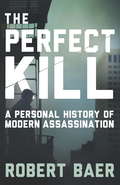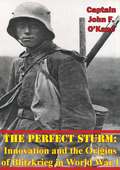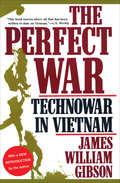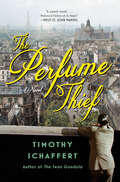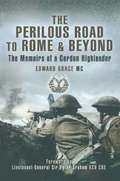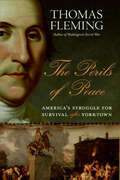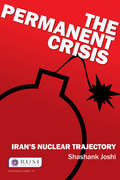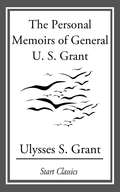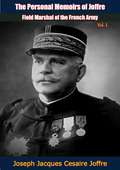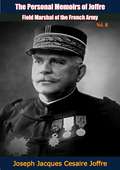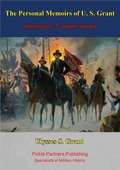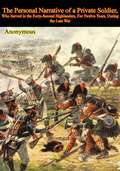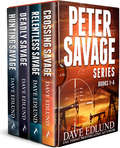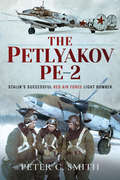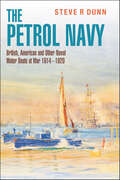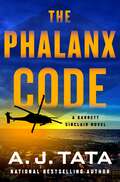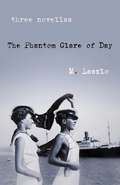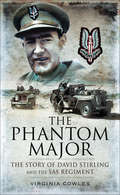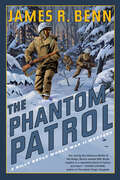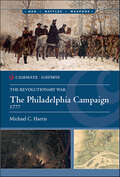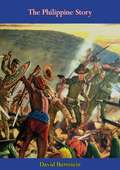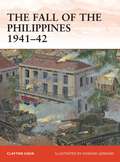- Table View
- List View
The Perfect Kill: 21 Laws for Assassins
by Robert BaerWhat is the definition of assassination? Robert Baer's boss at the CIA once told him, 'It's a bullet with a man's name on it.' Sometimes assassination is the senseless act of a psychotic, a bloodletting without social value. Other times, it can be the sanest and most humane way to change the course of conflict: one bullet, one death, case closed. Assassination has been dramatised by literature and politicised by infamous murders throughout history, and for Robert Baer, one of the most accomplished agents ever to work for the CIA, it's a source of endless fascination. Over several decades, Baer served as an operative, from Iraq to India and beyond. In THE PERFECT KILL, he takes us on a wildly entertaining narrative adventure through a history of political murder, interweaving his first-hand experience and his decades-long cat-and-mouse hunt for the greatest assassin of the modern age. A true maverick with an undeniably captivating personal story, Baer pulls back the curtain to give a glimpse of the underbelly of world politics, and the quiet murderers who operate on the fringe of our society.
The Perfect Sturm: Innovation and the Origins of Blitzkrieg in World War I
by Captain John F. O’Kane USAFWhat are the origins of tactical innovation in large, bureaucratic, military systems? This study will provide a detailed analysis of how the German Army in World War One took advantage of innovative tactical methods developed by their junior and non-commissioned officers (NCO) in the field. While many historians often look at the results of WWI from the perspective of the General officers and politicians (i.e., top-down), they often overlook the important roles played by creative junior officers in revolutionizing the manner in which the German Army fought. These innovations, when supported by senior leadership, led to massive operational and strategic gains for the German Army late in World War One. Moreover, the study will explore how the German Army successfully applied these tactical innovations at the Twelfth Battle of the Isonzo, a.k.a. The Battle of Caporetto in 1917. The result was a crushing Italian defeat. This success encouraged the German leadership to attempt similar offensives in 1918 on the Western Front in France. Initially successful, the offensives later stalled. However, the lessons of these attacks formed the basis for what would become universally known as the Blitzkrieg, or "lighting-war" tactics. These lessons continue to affect how modern militaries employ combined arms in maneuver warfare today. This case study will highlight the importance of "bottom-up" tactical innovation within today's U.S. military.
The Perfect War: Technowar in Vietnam
by James William Gibson&“Powerfully and persuasively . . . Gibson tells us why we were in Vietnam . . . a work of daring brilliance—an eye-opening chronicle of waste and self-delusion.&” —Robert Olen Butler In this groundbreaking book, James William Gibson shatters the misled assumptions behind both liberal and conservative explanations for America&’s failure in Vietnam. Gibson shows how American government and military officials developed a disturbingly limited concept of war—what he calls &“technowar&”—in which all efforts were focused on maximizing the enemy&’s body count, regardless of the means. Consumed by a blind faith in the technology of destruction, American leaders failed to take into account their enemy&’s highly effective guerrilla tactics. Indeed, technowar proved woefully inapplicable to the actual political and military strategies used by the Vietnamese, and Gibson reveals how US officials consistently falsified military records to preserve the illusion that their approach would prevail. Gibson was one of the first historians to question the fundamental assumptions behind American policy, and The Perfect War is a brilliant reassessment of the war—now republished with a new introduction by the author. &“This book towers above all that has been written to date on Vietnam.&” —LA Weekly
The Perfume Thief: A Novel
by Timothy SchaffertA LOS ANGELES TIMES TOP 10 BEST BOOK OF THE SUMMER A Gentleman in Moscow meets "Moulin Rouge" in this stylish, sexy page-turner set in Paris on the eve of World War II, where Clementine, a queer American ex-pat and notorious thief, is drawn out of retirement and into one last scam when the Nazis invade. "[A] superb novel . . . This is historical fiction at its finest, vivid and beautifully rendered."--EMILY ST JOHN MANDEL author of The Glass HotelClementine is a seventy-two year-old reformed con artist with a penchant for impeccably tailored suits. Her life of crime has led her from the uber-wealthy perfume junkies of belle epoque Manhattan, to the scented butterflies of Costa Rica, to the spice markets of Marrakech, and finally the bordellos of Paris, where she settles down in 1930 and opens a shop bottling her favorite extracts for the ladies of the cabarets. Now it's 1941 and Clem's favorite haunt, Madame Boulette's, is crawling with Nazis, while Clem's people--the outsiders, the artists, and the hustlers who used to call it home--are disappearing. Clem's first instinct is to go to ground--it's a frigid Paris winter and she's too old to put up a fight. But when the cabaret's prize songbird, Zoe St. Angel, recruits Clem to steal the recipe book of a now-missing famous Parisian perfumer, she can't say no. Her mark is Oskar Voss, a Francophile Nazi bureaucrat, who wants the book and Clem's expertise to himself. Hoping to buy the time and trust she needs to pull off her scheme, Clem settles on a novel strategy: Telling Voss the truth about the life and loves she came to Paris to escape. Complete with romance, espionage, champagne towers, and haute couture, this full-tilt sensory experience is a dazzling portrait of the underground resistance of twentieth-century Paris and a passionate love letter to the power of beauty and community in the face of insidious hate.
The Perilous Road to Rome and beyond: Fighting Through North Africa And Italy
by Edward GraceThe author fought with the 6th Battalion of the Gordon Highlanders during the campaigns of 1st Army in Tunisia and in Italy thereafter. As a young platoon commander he and his men were in the thick of the fighting. Wounded during the desperate action at Anzio, he wrote notes of all that had happened in exact detail and the result is a memoir both fresh and authentic. This is one of the most gripping memoirs we have published, on a par with Geoffrey Powell's Men At Arnhem The author also describes the actions of other regiments, particularly the Guards Brigade at Anzio, and US units, alongside whom he fought. In the closing stages of the book he shares his post-conflict experiences and convalescence with the reader in a moving way.
The Perils of Peace: America's Struggle for Survival After Yorktown
by Thomas FlemingThe acclaimed historian presents a “captivating account of a surprisingly little-known period” at the close of the American Revolution (Kirkus, starred review).On October 19, 1781, Great Britain’s best army surrendered to General George Washington at Yorktown. But the future of the thirteen former colonies was far from clear. 13,000 British troops still occupied New York City, and another 13,000 regulars and armed loyalists were scattered from Canada to Georgia. Meanwhile, the American army had not been paid for years and was on the brink of mutiny.In Europe, America’s only ally, France, teetered on the verge of bankruptcy and was soon reeling from a disastrous naval defeat in the Caribbean. A stubborn George III dismissed Yorktown as a minor defeat and refused to yield an acre of “my dominions” in America. In Paris, Ambassador Benjamin Franklin confronted violent hostility toward France among his fellow members of the American peace delegation.In The Perils of Peace, Thomas Fleming moves between the key players in this drama and shows that the outcome we take for granted was far from certain. With fresh research and masterful storytelling, Fleming breathes new life into this tumultuous but little known period in America’s history.
The Permanent Crisis: Iran’s Nuclear Trajectory (Whitehall Papers)
by Shashank JoshiThe quickening pace of Iran’s nuclear activities has produced an international sense of urgency. Sanctions have intensified, while fears of an Israeli strike abound. Talks have briefly eased the tension, before failing due to fundamental differences between Iran and the West. There seem to be dim prospects for peaceful resolution; the worry is that this long-running dispute could become a permanent crisis. This Whitehall Paper tackles the Iranian nuclear dispute in its full context to determine what possible compromises may exist and how they may be achieved. While the crisis is embedded in a set of overlapping security disputes between Iran on the one hand, and the United States, Arab regional powers, Israel and the broader ‘West’ on the other, it is also important to analyse it in a comparative and thematic context. Iran’s programme is not sui generis: previous experience can help to inform our assessments of how Iran will be affected by, and respond to, intense multilateral economic and political pressure, and what its nuclear posture might be. This study also examines how policy responses by the West should evolve were Iran to resume its alleged nuclear-weapons programme, continue to undertake some degree of near-weaponisation or weaponisation, or test and deploy nuclear weapons. The Permanent Crisis questions the assumptions and logic of alarmist studies – those which see a nuclear Iran as fanatical, unresponsive to deterrence and certain to precipitate a wave of unstoppable nuclear proliferation – whilst outlining the very real risks that would flow from such a failure of Western policy.
The Persian Gulf Crisis
by Randall M. Miller Steve A. YetivOne in a series by the Greenwood Press entitled Guide to Events of the Twentieth Century.
The Persian Wars
by Herodotus George Rawlinson R. B. GodolphinFeatures an introduction by Francis RB Godolphin.
The Personal Memoirs of General U. S.
by Ulysses S. GrantAmong the autobiographies of generals and presidents, the Personal Memoirs of U.U. Grant ranks with the greatest. It is even more impressive in light of the circumstances in which it was created: Faced with terminal cancer, virtual bankruptcy, and a family he would leave without means of support, he took the advice of his publisher, mark Twain, and went to work. He completed the manuscript in eleven months-and died a week later, on July 23, 1885. Frank and unpretentious, Grant's memoirs tell the story of his boyhood in Ohio, his graduation from West Point, and the military campaigns in the West and Mexico that ended with his disgraceful resignation and a return to Illinois, where he ran the family store. Soon, however, began the rebellion that broke the Union and recast Grant's fortune, transforming him into the leader of the victorious Union armies in the War Between the States and giving him the perspective to describe intimately the capture of Fort Henry and Fort Donelson, the battles of Shiloh, Corinth, Vicksburg, the bloody Wilderness campaign, and Appomattox. Here is Grant the tactician, the alcoholic, the plain and tough professional soldier, the ideal commander-but most of all here is Grant the writer as he assesses himself and the events that forged his character, as well as that of the nation.
The Personal Memoirs of Joffre, Field Marshal of the French Army, Vol. I (The Personal Memoirs of Joffre #1)
by Joseph Jacques Cesaire Joffre Colonel S. J. LoweFirst published posthumously in 1932, this is the first volume of two that comprise French Field Marshal Joffre’s fascinating memoirs.Volume I takes the reader on a journey of his experiences in the years before the commencement of World War I, through to the days immediately preceding the War and the various battles of 1914 that he led, including the Battle of Marne.Richly illustrated throughout with pictures and maps.“This book, written by the chief actor, unfolds the history of a great campaign upon which hung the destiny of civilization.”—John J. Pershing“Joffre was not only the greatest commander in chief of the World War, but also, as the chief of a general staff, the superior of the elder Moltke himself.”—Frank H. Simonds
The Personal Memoirs of Joffre, Field Marshal of the French Army, Vol. II (The Personal Memoirs of Joffre #2)
by Joseph Jacques Cesaire Joffre Colonel S. J. LoweFirst published posthumously in 1932, this is the second and final volume of French Field Marshal Joffre’s fascinating memoirs.Volume II picks up where Volume I left off at the conclusion of 1914 and takes the reader through to the year 1915, which included the operations in France and Belgium, through to the Allied General offensive of 1916 in Verdun and the Battle of the Somme, and, finally, Field Marshall Joffre’s resignation from politics and his subsequent mission to America.Richly illustrated throughout with pictures and maps.“This book, written by the chief actor, unfolds the history of a great campaign upon which hung the destiny of civilization.”—John J. Pershing“Joffre was not only the greatest commander in chief of the World War, but also, as the chief of a general staff, the superior of the elder Moltke himself.”—Frank H. Simonds
The Personal Memoirs of U. S. Grant [Illustrated – 2 volumes in one]
by General Ulysses S. GrantIncludes Civil War Map and Illustrations Pack - 224 battle plans, campaign maps and detailed analyses of actions spanning the entire period of hostilities.Few military memoirs have had the impact of those of General Grant, a best-seller on publication, considered a classic ever since both but military and literary critics. Mark Twain reflected that he "had been comparing the memoirs with Caesar's Commentaries... I was able to say in all Apologetic forms that the same high merits distinguished both books - clarity of statement, directness, simplicity, manifest truthfulness, fairness and justice toward friend and foe alike and avoidance of flowery speech. General Grant was just a man, just a human being, just an author...The fact remains and cannot be dislodged that General Grant's book is a great, unique and unapproachable literary masterpiece. There is no higher literature than these modest, simple Memoirs. Their style is at least flawless, and no man can improve upon it."Highly recommended.Author -- General Ulysses S. Grant (1822-1885)Text taken, whole and complete, from the edition published in 1885-86, New York, C.L. Webster & Co.
The Personal Narrative of a Private Soldier: Who Served in the Forty-Second Highlanders, For Twelve Years, During the Late War
by AnonymousOriginally published in 1821, this book vividly describes scenes of war with all its maddening excitement and all its horrors, as experienced by an anonymous Private who served in the 42nd Highlanders for 12 years during the latter part of the Peninsula War.Inspired by the narrative of an earlier published military diary entitled The Journal of a Solider of the 71st (1819), and having known our anonymous 42nd Soldier since childhood, the (likewise anonymous) editor of The Personal Narrative of a Private Soldier said to himself, "Why might not ******* write the personal Narrative of his Life, as 'a poor, but honest Soldier?'"Subsequently, having read the 71st Soldier's journal "with mingled feelings of pleasure and regret," the editor approached the 42nd Soldier and requested from him, via letters, "a brief but faithful relation of what he did and what he saw, from the time he enlisted till he was discharged in 1814."And thus was born this highly informative first-hand account of one of the most significant wars in history...
The Peter Savage Novels Boxed Set: (Books 1-4) (Peter Savage)
by Dave EdlundThe Peter Savage Series Books 1-4 by bestselling, award-winning author Dave Edlund have taken readers around the world on a deadly race to energy independence, dropped them in a battle to end a genocide, made them stare down a threat of bioterrorism, and unearthed an unthinkable act of treason threatening to redraw the map of the Middle East.The Peter Savage novels have been lauded for their "crackling action" (Kirkus Reviews), and come "highly recommended to fans of thrillers" (Foreword Reviews). The New York Times and #1 international bestselling author Steve Berry praises Peter Savage as "a hero full of grit and determination" and calls the series "required reading for any thriller aficionado.”Now, you can purchase the first four books of the Peter Savage Series for over 60% off!CROSSING SAVAGEIn this edge-of-your-seat thriller, author Dave Edlund brings readers face to face with the promise of energy independence... and its true cost. As one by one the world’s leading alternative energy researchers are assassinated, Peter Savage and his friend Jim Nicolaou race against the clock to preserve the secret that promises to change the landscape of the world... or start a global war. In the timely, heart-thumping thriller Crossing Savage, author Dave Edlund presents the theory of abiogenic oil production and the terrifying array of unintended consequences that accompany the belief that energy independence can be realized.RELENTLESS SAVAGEIn this fast-paced, action-driven adventure Peter Savage confronts a hidden genocide, genetic manipulation, and a tipping point in the balance of world power.When Peter Savage's son Ethan is kidnapped by rebel forces in Sudan while on a service trip, Peter will stop at nothing to get his son home. Recruiting old friends and tapping into the expertise of Commander James Nicolau, Peter puts together an unlikely rescue mission that will pit him against deadly forces. What Peter and his team find in the Sudan is a force far more sinister and dangerous than they could ever imagine. They are drawn into a much larger top-secret government mission, one that leads them to a hidden research site with an army of genetically-perfect soldiers.DEADLY SAVAGEFrom the award-winning Peter Savage novels comes a tale of political intrigue, biological warfare, and the fragile balance of world power.When militants invade the Belarusian State University in Minsk, Peter and his father are caught in the crossfire. Held hostage by gunmen who look suspiciously like Russian soldiers, Peter Savage uncovers a deadly plot to kill thousands of innocent civilians—and lay the blame at the feet of the United States government. In a desperate attempt to avoid a global war, Commander James Nicolaou and Peter are called to the front lines of the sinister campaign, and the stakes have never been higher.HUNTING SAVAGEWhen an unthinkable act of treason and a clandestine pact threaten to redraw the map of the Middle East, Peter Savage becomes both hunter and prey.A free-lance hacker uncovers top-secret files about a government cover-up surrounding the 1967 Six-Day War and triggers a murderous rampage at a resort town in Central Oregon. When the files inadvertently land in the possession of Peter Savage, he is targeted by assassins from both sides of the Atlantic and implicated in murders he didn’t commit. As the body count rises and with nowhere to turn, Savage makes a desperate decision: he draws his pursuers to the Cascade Mountains, where he plans to leverage the harsh terrain to his advantage. Doggedly trailed by both law enforcement and a small army of battle-hardened assassins, Savage becomes both hunter and prey. With his own fate uncertain, Peter Savage fights overwhelming odds to reveal the truth before full-scale war engulfs the Middle East.
The Petlyakov Pe-2: Stalin's Successful Red Air Force Light Bomber
by Peter C. SmithThe definitive book on the development and deployment of the Soviet Union’s supreme dive-bomber—with rare archival and private photos.During the Second World War, the Petlyakov Pe-2 Peshka was the Soviet Union’s main dive- and light-bomber in operations across the Eastern Front. It became a mainstay of the Soviet counteroffensive that led to the fall of Berlin. They also led the way in the brief but annihilating Manchurian campaign against Japan in the closing days of the war in 1945.Conceived by a team of top aircraft designers whom Stalin had incarcerated on political charges, the Peshka had originally been designed as a high-altitude twin-engine fighter plane. But due to the outstanding success of the German Stukas in the Blitzkrieg, it was quickly transformed into the fastest dive-bomber in the skies.Only a handful had reached front lines by the start of Operation Barbarossa in June 1941. But by 1945, more than 11,000 of the type were built, including many variants. Many of these remained in service with the air forces of Yugoslavia and the Warsaw Pact countries into the 1950s. Using official sources, including the official Pe-2 handbook, as well as rare color and black-and-white photographs from both official and private collections, this is the definitive record of the Pe-2.
The Petlyakov Pe-2: Stalin's Successful Red Air Force Light Bomber
by Peter C. SmithThe definitive book on the development and deployment of the Soviet Union’s supreme dive-bomber—with rare archival and private photos.During the Second World War, the Petlyakov Pe-2 Peshka was the Soviet Union’s main dive- and light-bomber in operations across the Eastern Front. It became a mainstay of the Soviet counteroffensive that led to the fall of Berlin. They also led the way in the brief but annihilating Manchurian campaign against Japan in the closing days of the war in 1945.Conceived by a team of top aircraft designers whom Stalin had incarcerated on political charges, the Peshka had originally been designed as a high-altitude twin-engine fighter plane. But due to the outstanding success of the German Stukas in the Blitzkrieg, it was quickly transformed into the fastest dive-bomber in the skies.Only a handful had reached front lines by the start of Operation Barbarossa in June 1941. But by 1945, more than 11,000 of the type were built, including many variants. Many of these remained in service with the air forces of Yugoslavia and the Warsaw Pact countries into the 1950s. Using official sources, including the official Pe-2 handbook, as well as rare color and black-and-white photographs from both official and private collections, this is the definitive record of the Pe-2.
The Petrol Navy: British, American and Other Naval Motor Boats at War 1914–1920
by Steve DunnOn the outbreak of war in 1914, the Royal Navy found it required more small craft than it possessed to carry out minesweeping, anti-submarine patrols and coastal defense. This led to the formation of an auxiliary force of civilian vessels, including motor pleasure boats and yachts, relatively new types of craft powered by the internal combustion engine. The inclusion of these vessels came about when a group of motor boat owners suggested to the Admiralty that their vessels could play an important role in the defense of Britain. The result was the formation of the Royal Naval Motor Boat Reserve (RNMBR) in 1912. By mid-1915, the demands of naval duty had proved too much for these quirky craft. A meeting in the USA led to their replacement by American-designed Elco motor launches (MLs), of which 550 were purchased, and these Elco launches gave great service for the rest of the war, usually officered by RNVR personnel who won three Victoria Crosses. In addition to the Elcos, in 1915 some naval officers developed the hydroplaning coastal motor boats (CMBs), which served with equal distinction in the latter part of the war. Post-war, both types saw valuable service in the occupation of the Rhineland and in the Baltic campaign, where three more VCs were won. Other countries adopted similar craft. In Italy, the MAS torpedo motor craft achieved fame and success. And in France, MLs supplied by Britain, and by Elco, played their part. Germany too utilized small motor vessels, including the torpedo-armed Luftschiffmotorboote and Fernlenkboot remotely controlled designs. And when America entered the war, she built a fleet of so-called ‘sub chasers’, wooden-built and designed to counter U-boats along her East Coast. The Petrol Navy tells the stirring story of these motor-driven boats at war, of their development and operations and of the many colorful characters who were their captains and crew. It will acquaint historians and enthusiasts with an important and previously untold aspect of the naval war, and will engross those with a more general interest in the First World War.
The Phalanx Code: A Garrett Sinclair Novel (Garrett Sinclair #3)
by A. J. TataGarrett Sinclair escapes from prison to rescue his team from the manipulations of two tech moguls and learns of a devastating family secret in the process.Influential tech magnate Mitch Drewson calls on Sinclair and the Dagger team to protect his Project Optimus. An ambitious endeavor that empowers citizens to protect their financial and personal data in the face of increasingly authoritarian federal governments, Project Optimus is a threat to Aurelius Blanc’s Phalanx Corporation. Blanc’s data collection and media application are enabling a global security threat, creating a technofascism that monitors the activity of everyone with a smartphone, tablet, computer, or any web-connected device.When Phalanx assassin squads overrun an Optimus server farm in California and attack an Optimus coder named Blair Campbell, who happens to be the president’s daughter, Sinclair must deploy a group of warriors to save Blair and protect the remainder of the Optimus team so they can finish their important work—a project that includes deciphering the mysterious Phalanx Code, suspected to be Phalanx’s kill list of Optimus employees.With Phalanx squads hunting him and those he loves, Sinclair must determine who he can trust while a part of his past comes back to haunt him and threaten everything he holds dear. Nonstop action and authentic detail make this the most compelling, high-stakes entry in the Sinclair series yet.
The Phantom Glare of Day: Three Novellas
by M. LaszloIn this trio of novellas, three game young ladies enter into dangerous liaisons that test each one&’s limits and force them to confront the most heartrending issues facing society in the early twentieth century. The Phantom Glare of Day tells of Sophie, a young lady who has lived a sheltered life and consequently has no idea how cruel public school bullying can be. When she meets Jarvis, a young man obsessed with avenging all those students who delight in his daily debasement, she resolves to intervene before tragedy unfolds. Mouvements Perpétuels tells of Cäcilia, a young lady shunned by her birth father. She longs for the approval of an older man, so when her ice-skating instructor attempts to take advantage of her, she cannot resist. Not a month later, she realizes that she is pregnant and must decide whether or not to get an abortion. Passion Bearer tells of Manon, a young lady who falls in love with a beautiful actress after taking a post as a script girl for a film company—and is subsequently confronted with the pettiest kinds of homophobia. Specific to their time yet unquestionably relevant for women today, The Phantom Glare of Day is a compelling interrogation of who gets to decide what is right and what is wrong.
The Phantom Major: The Story of David Stirling and the SAS Regiment
by Virginia CowlesAn action-packed biography of &“one of the legitimate storybook heroes of World War II&” and the special forces regiment he founded (The New York Times). In the dark and uncertain days of 1941 and 1942, when Rommel&’s Afrika Korps was sweeping toward Egypt and the Suez Canal, a small group of daring raiders made history for the Allies. They operated deep behind German lines, driving hundreds of miles through the deserts of North Africa. They hid by day and struck by night, destroying aircraft, blowing up ammunition dumps, derailing trains, and killing many times their own number. These men were the Special Air Service. The SAS was the brainchild of David Stirling, a deceptively mild-mannered man with a brilliant idea. Under his command, small teams of resourceful, highly trained men penetrated beyond the front lines of the opposing armies and wreaked havoc where the Germans least expected it. From Virginia Cowles, whose biographies have been praised as &“splendidly readable&” (Sunday Times) and &“fascinating&” (Kirkus Reviews), this is a classic account of these raids, an amazing tale of courage, impudence, and daring packed with action and high adventure. Her narrative, based on the eyewitness testimony of the men who took part, gives a compelling insight into the early years of the SAS.
The Phantom Patrol (A Billy Boyle WWII Mystery #19)
by James R. BennAn investigation into a gang of Nazi-affiliated art thieves Leads Billy Boyle directly into the line of fire at the catastrophic Battle of the Bulge.Winter 1944: Months after the Liberation of France, ex-Boston cop Billy Boyle finds himself in Paris. It is a city reeling from the carnage it has endured, but many are hopeful an end to war is in sight. When Billy finds a rare piece of artwork after a tense shoot-out in the Père Lachaise Cemetery, he thinks it could be connected to the Syndicat du Renard, a shadowy network of Nazi sympathizers known to be smuggling stolen artwork out of France.Trailing the Syndicat, Billy discovers that someone with a high level of communications clearance—someone in the Phantom regiment of the British Army—may be using his position to aid the thieves. Billy, determined to stop the abettor, heads up to the frontlines where he experiences a last-ditch battle against overwhelming odds. There, the ruinous Battle of the Bulge unfurls in the Ardennes Forest. Can Billy and his team survive the bracing onslaught and return the stolen artwork to its rightful protectors?
The Philadelphia Campaign, 1777 (Casemate Illustrated)
by Michael C. HarrisDetailed and fully illustrated account of the Philadelphia campaign 1777, with over 150 photographs, maps and contemporary artwork. The British Army in North America conducted two campaigns in 1777. John Burgoyne led one army south from Canada to seize control of the Lake Champlain-Hudson River corridor resulting in the battle of Saratoga. Burgoyne’s defeat led to that army’s capture. Rather than assist Burgoyne’s campaign, William Howe led his army from New York City on the Philadelphia campaign. Although Howe captured Philadelphia, the events of 1777 led to the French Alliance and ultimately American victory in American Revolution. This fully illustrated account of the Philadelphia campaign puts the battles into context and explains the importance of the campaign to the outcome of the war.
The Philippine Story
by David BernsteinPublished a year after the Philippines proclaimed independence in July 1946, the chief permanent value of this book lies in its survey of the history of the American experiment in the Philippines. The Philippine Story is a concise, inclusive analysis of the background, failure, achievements and implications of the American experiment in the Philippines, from Magellan to the present post-war era. The author, David Bernstein, sketches in an overall impression: geography, education, religion, anthropology, national characteristics, and so on. He then goes on to consider each major phase of island history, the acquiescent period of Spanish rule, the era of revolt with Rizal as its inspiration and later national hero, the transition to American rule and the rapid progress in education and social and economic justice under successive Governors-General. The final section deals with the war years and the new republic.An invaluable read that challenges America’s policies.
The Philippines 1941-42
by Howard Gerrard Clayton ChunThe Philippine Islands were one of two major US bases in the Pacific, the other being Pearl Harbor. The Japanese considered the capture of the Philippines crucial for its efforts to control resource-laden Southeast Asia. As opposed to its attack on Pearl Harbor, the Japanese intention was to invade and occupy the Philippines in a campaign that was to last five months. The flamboyant Douglas MacArthur, a hero of World War I and former Chief of Staff led the defense of the Philippines when the Japanese attacked on 8 December 1941. Despite warnings about the Pearl Harbor attack, the Japanese air forces caught MacArthur's aircraft on the ground resulting in half of his modern bomber and fighter aircraft destroyed. Army Air Forces B-17s attempted to bomb Formosa, but Japanese fighters eliminated them and a Japanese full-scale invasion followed days later.Japanese forces landed in northern Luzon from Formosa. B-17s and naval attacks tried in vain to stop the invasion, but failed. Poorly trained and equipped Philippine Army units could not halt the Japanese and the American and Filipino forces withdrew, even though they outnumbered the initial Japanese forces. Japanese Army units broke through several defensive lines as they drove on to Manila, which was abandoned by the Americans as Macarthur withdrew to Bataan. The Japanese gradually reduced this pocket until the only American position was Corregidor Island. MacArthur left for Australia, as a direct order from President Franklin Roosevelt and was awarded the Medal of Honor, one of the more controversial aspects of the campaign. With little hope of survival, Corregidor fell, with organized resistance ending on 9 May 1942.Although a defeat, the American and Filipino defensive efforts upset the Japanese plan for a swift victory and provided time for Australia and the United States to build up their defenses. It also gave hope to the American public that Americans could stand up to Japan, with the "Battling Bastards of Bataan" providing a source of inspiration. Unfortunately, for the survivors of the campaign, it meant a grueling three years of captivity for some. The Bataan Death March was one of the most infamous events in World War II, with Japanese forces responsible for the deaths of about 600 Americans and between 5,000-10,000 Filipino soldiers dying in the march, some summarily executed by beheading.
